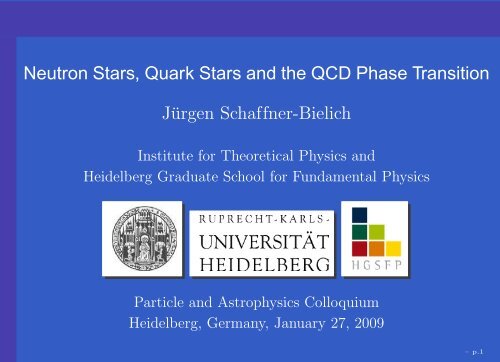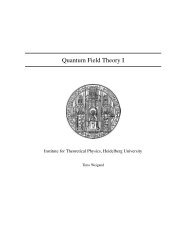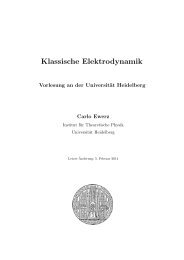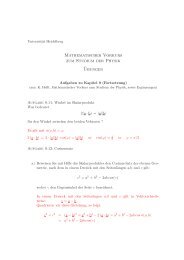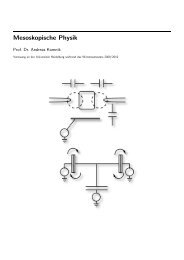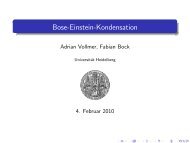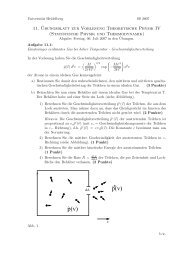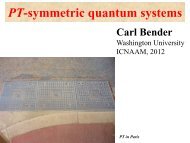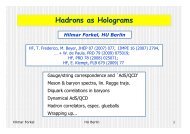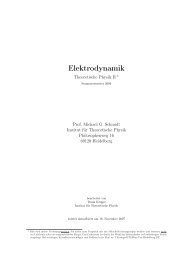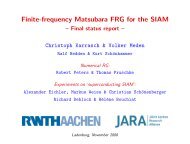neutron stars - Universität Heidelberg
neutron stars - Universität Heidelberg
neutron stars - Universität Heidelberg
You also want an ePaper? Increase the reach of your titles
YUMPU automatically turns print PDFs into web optimized ePapers that Google loves.
Neutron Stars, Quark Stars and the QCD Phase Transition<br />
Jürgen Schaffner-Bielich<br />
Institute for Theoretical Physics and<br />
<strong>Heidelberg</strong> Graduate School for Fundamental Physics<br />
Particle and Astrophysics Colloquium<br />
<strong>Heidelberg</strong>, Germany, January 27, 2009<br />
– p.1
UniSpiegel, <strong>Universität</strong> <strong>Heidelberg</strong>, December 2008<br />
– p.2
UniSpiegel, <strong>Universität</strong> <strong>Heidelberg</strong>, December 2008<br />
Thanks for the warm welcome!<br />
– p.2
Rhein-Neckar-Zeitung, 09.01.2009<br />
– p.3
Rhein-Neckar-Zeitung, 09.01.2009<br />
my blackboard notes are already in the local newspaper!<br />
– p.3
Outline<br />
Introduction: observational data on <strong>neutron</strong> <strong>stars</strong><br />
Properties of <strong>neutron</strong> <strong>stars</strong> and quark <strong>stars</strong><br />
QCD phase transition and supernovae<br />
– p.4
Observational Data on Neutron Stars<br />
– p.5
Supernova Explosions<br />
(supernova simulation by Janka et al.,<br />
MPA Garching)<br />
<strong>stars</strong> with a mass of more than 8<br />
solar masses end in a (core<br />
collapse) supernova (type II)<br />
Supernova of AD 1054 was visible<br />
for three weeks during daytime<br />
(crab nebula)!<br />
supernovae are several thousand<br />
times brighter than a whole galaxy!<br />
last supernova explosion for the last<br />
400 years in our local group:<br />
SN1987A<br />
most prominent candidate in the universe<br />
for producing the heavy elements<br />
(r-process)<br />
– p.6
Neutron Stars<br />
Movie (seven still images in 11/2000–04/2001)<br />
produced in core collapse<br />
supernova explosions<br />
compact, massive objects:<br />
radius ≈ 10 km, mass<br />
1 − 2M⊙<br />
extreme densities, several<br />
times nuclear density:<br />
n ≫ n0 = 3 · 10 14 g/cm 3<br />
in the middle of the crab<br />
nebula: a pulsar, a rotating<br />
<strong>neutron</strong> star!<br />
– p.7
The Pulsar Diagram<br />
(ATNF pulsar catalog)<br />
the diagram for pulsars: period<br />
versus period change (P- ˙P)<br />
dipole model for pulsars:<br />
characteristic age: τ = P/(2P) ˙<br />
and magnetic field<br />
B = 2 · 1019 (P · P) ˙ 1/2 Gauss<br />
anomalous x-ray pulsars: AXP,<br />
soft-gamma ray repeaters:<br />
SGR, young pulsars in<br />
supernova remnants: SNR<br />
rapidly rotating pulsars (millisecond<br />
pulsars): mostly in binary<br />
systems (old recycled pulsars!)<br />
– p.8
Masses of Pulsars (Stairs, 2006)<br />
more than 1600 pulsars<br />
known<br />
best determined mass:<br />
M = (1.4414 ± 0.0002)M⊙<br />
for the Hulse-Taylor pulsar<br />
(Weisberg and Taylor, 2004)<br />
smallest known mass:<br />
M = (1.18 ± 0.02)M⊙ for<br />
pulsar J1756-2251 (Faulkner<br />
et al., 2005)<br />
PSR J0751+1807 corrected<br />
from M = 2.1 ± 0.2M⊙ to<br />
M = 1.14 − 1.40M⊙ (Nice et<br />
al. 2008) – p.9
Supermassive Pulsar in Globular Cluster?<br />
(Freire et al., arXiv:0711.0925v2 (2007))<br />
15<br />
o<br />
o<br />
30<br />
45<br />
60<br />
90<br />
o<br />
o<br />
o<br />
measurement of periastron<br />
advance of the pulsar PSR<br />
J1748-2021B<br />
inclination angle i of orbital<br />
plane unknown<br />
statistical analysis (for angle i):<br />
M = 2.74 ± 0.21M⊙ (1σ) and<br />
M > 2.0M⊙ (99% c.l.)<br />
two <strong>neutron</strong> <strong>stars</strong> with<br />
M ∼ 1.4M⊙ ’unlikely’ but<br />
possible for i = 4 − 5 degrees<br />
measurement of a second GR<br />
effect needed to draw a firm<br />
conclusions!<br />
– p.10
How To Measure Masses AND Radii of Compact Stars<br />
mass from binary systems (pulsar with a companion star)<br />
radius and mass from thermal emission, for a blackbody:<br />
F∞ = L∞<br />
4πd 2 = σSBT 4 eff,∞<br />
� R∞<br />
d<br />
with Teff,∞ = Teff/(1 + z) and R∞ = R/(1 + z)<br />
redshift:<br />
1 + z =<br />
�<br />
1 − 2GM<br />
R<br />
� −1/2<br />
need to know distance and effective temperature to get R∞<br />
radius measured depends on true mass and radius of the star<br />
additional constraint from redshift measurement from e.g.<br />
redshifted spectral lines fixes mass and radius uniquely<br />
� 2<br />
– p.11
Isolated Neutron Star RX J1856 (Drake et al. (2002))<br />
closest known <strong>neutron</strong> star, parallax measurement with HST:<br />
D = 117 ± 12 pc (Lattimer and Wolter 2002), D = 140 ± 40 pc (van Kerkwijk<br />
and Kaplan 2004), D = 161 ± 18 pc (Kaplan 2007)<br />
perfect black–body spectrum, no spectral lines!<br />
for black-body emission (x-ray part only): T = 60 eV and R∞ = 4 − 8 km!– p.12
Constraints on the Mass–Radius Relation (Lattimer and Prakash (2004))<br />
spin rate from PSR B1937+21 of 641 Hz: R < 15.5 km for M = 1.4M⊙<br />
Schwarzschild limit (GR): R > 2GM = Rs<br />
causality limit for EoS: R > 3GM<br />
only quark <strong>stars</strong> can have small radii! – p.13
A Quark Star? (NASA press release 2002)<br />
NASA news release 02-082:<br />
“Cosmic X-rays reveal evidence for new form of matter”<br />
— a quark star?<br />
– p.14
Neutron Star versus Strange Quark Star<br />
(Chandra X-Ray Center, 2002)<br />
– p.15
RXJ 1856: Neutron Star or Quark Star? (Ho et al. (2007))<br />
F λ (ergs s −1 cm −2 A −1 )<br />
10 −12<br />
10 −13<br />
10 −14<br />
10 −15<br />
10 −16<br />
10 −17<br />
10 −18<br />
10 −19<br />
10 −20<br />
10 1<br />
XMM/RGS<br />
CXO/LETG<br />
EUVE<br />
10 2<br />
Wavelength (A)<br />
10 3<br />
HST/STIS<br />
VLT/FORS1<br />
HST/STIS<br />
CXO/LETG<br />
XMM/RGS<br />
EUVE<br />
VLT/FORS2<br />
HST/WFPC2<br />
VLT/FORS1<br />
two-temperature black-body fit implies a lower limit for radiation radius:<br />
R∞ = R/ � 1 − 2GM/R ≈ 17 km (d/140 pc)<br />
thin magmetized H-atmosphere on condensed iron core (Ho et al.):<br />
redshift zg ≈ 0.22: R ≈ 14 km and M ≈ 1.55M⊙<br />
not necessarily a quark star!<br />
10 4<br />
– p.16
X-Ray burster<br />
binary systems of a <strong>neutron</strong> star with an ordinary star<br />
accreting material on the <strong>neutron</strong> star ignites nuclear burning<br />
explosion on the surface of the <strong>neutron</strong> star: x-ray burst<br />
red shifted spectral lines measured!<br />
(z = 0.35 → M/M⊙ = 1.5 (R/10 km)) (Cottam, Paerels, Mendez (2002))<br />
– p.17
X-Ray burster EXO 0748–676: the EoS is hard!<br />
Mass M [M ]<br />
2.4<br />
2.0<br />
1.6<br />
1.2<br />
0.8<br />
Hybrid, mixed<br />
(CFL+APR)<br />
Neutron star<br />
(DBHF)<br />
2σ<br />
EXO 0748-676<br />
Hybrid<br />
(2SC+DBHF)<br />
Quark star<br />
(QCD O(α s 2 )) Hybrid<br />
(2SC+HHJ)<br />
0.4<br />
7 8 9 10 11 12 13 14 15<br />
Radius R [km]<br />
analysis of Özel (Nature 2006): M ≥ 2.10 ± 0.28M⊙ and R ≥ 13.8 ± 1.8 km,<br />
claims: ’unconfined quarks do not exist at the center of <strong>neutron</strong> <strong>stars</strong>’!<br />
reply by Alford, Blaschke, Drago, Klähn, Pagliara, JSB (Nature 445, E7<br />
(2007)): limits rule out soft equations of state, not quark <strong>stars</strong> or hybrid <strong>stars</strong>!<br />
multiwavelength analysis of Pearson et al. (2006): data more consistent with<br />
M = 1.35M⊙ than with M = 2.1M⊙<br />
1σ<br />
– p.18
Properties of Neutron Stars and Quarks Stars<br />
– p.19
Structure of Neutron Stars — the Crust (Dany Page)<br />
n ≤ 10 4 g/cm 3 :<br />
atmosphere<br />
(atoms)<br />
n = 10 4 − 4 · 10 11 g/cm 3 :<br />
outer crust or envelope<br />
(free e − , lattice of nuclei)<br />
n = 4 · 10 11 − 10 14 g/cm 3 :<br />
Inner crust<br />
(lattice of nuclei with free<br />
<strong>neutron</strong>s and e − )<br />
– p.20
Structure of a Neutron Star — the Core (Fridolin Weber)<br />
hyperon<br />
star<br />
strange star<br />
quark−hybrid<br />
star<br />
absolutely stable<br />
strange quark<br />
matter<br />
µ<br />
p<br />
u,d,s<br />
quarks<br />
m s<br />
n,p,e, µ<br />
n,p,e, µ<br />
s u e r c n d c t g<br />
u d s<br />
Σ,Λ,Ξ,∆<br />
H<br />
o<br />
N+e<br />
N+e+n<br />
u<br />
K −<br />
i<br />
n<br />
−<br />
π<br />
p r o t o n s<br />
R ~ 10 km<br />
M ~ 1.4 M<br />
traditional <strong>neutron</strong> star<br />
n superfluid<br />
crust<br />
nucleon star<br />
<strong>neutron</strong> star with<br />
pion condensate<br />
Fe<br />
g/cm 3<br />
10 6<br />
10 11<br />
10 14<br />
g/cm 3<br />
g/cm 3<br />
– p.21
Phase Transitions in Quantum Chromodynamics QCD<br />
T<br />
Tc<br />
early universe<br />
RHIC, LHC<br />
Hadrons<br />
nuclei<br />
m / 3<br />
N<br />
Quark−Gluon<br />
FAIR<br />
Color<br />
Superconductivity<br />
<strong>neutron</strong> <strong>stars</strong><br />
µ<br />
c<br />
Plasma<br />
Early universe at zero density and high temperature<br />
<strong>neutron</strong> star matter at small temperature and high density<br />
first order phase transition at high density (not deconfinement)!<br />
probed by heavy-ion collisions at GSI, Darmstadt (FAIR!)<br />
µ<br />
– p.22
Quark matter in the NJL model<br />
p = 1<br />
2π 2<br />
−2GS<br />
18�<br />
� Λ<br />
i=1<br />
3�<br />
α=1<br />
0<br />
dk k 2 |ǫi| + 4Kσuσdσs − 1<br />
σ 2 α + 1<br />
4GV<br />
ω 2 0 + pe<br />
4GD<br />
3�<br />
|∆c| 2<br />
use Nambu–Jona-Lasinio model for describing quark matter<br />
describes both dynamical quark masses (quark condensates σ)<br />
and the color-superconducting gaps ∆ (Rüster et al. (2005))<br />
parameters: cutoff, scalar and vector coupling constants GS, GV ,<br />
diquark coupling GD, ’t Hooft term coupling K<br />
fixed to hadron masses, pion decay constant, free: GD and GV<br />
c=1<br />
– p.23
Phases in Quark Matter (Rüster et al. (2005))<br />
T [MeV]<br />
60<br />
50<br />
40<br />
30<br />
20<br />
10<br />
χSB<br />
NQ<br />
g2SC<br />
NQ<br />
←gCFL<br />
0<br />
320 340 360 380 400 420 440 460 480 500<br />
µ [MeV]<br />
2SC<br />
guSC→<br />
first order phase transition based on symmetry arguments!<br />
phases of color superconducting quark matter in β equilibrium:<br />
normal (unpaired) quark matter (NQ), two-flavor color superconducting phase<br />
(2SC), gapless 2SC phase, color-flavor locked phase (CFL), gapless CFL<br />
phase, metallic CFL phase<br />
(Alford, Rajagopal, Wilczek, Reddy, Buballa, Blaschke, Shovkovy, Drago, Rüster, Rischke,<br />
Aguilera, Banik, Bandyopadhyay, Pagliara, . . . ) – p.24<br />
CFL<br />
uSC
Mass-radius and maximum density of pure quark <strong>stars</strong><br />
M/M sun<br />
2<br />
1.5<br />
1<br />
0.5<br />
0<br />
B 1/4<br />
=200 MeV<br />
Λ=2µ<br />
B 1/4<br />
=145 MeV<br />
Λ=3µ<br />
0 5 10 15<br />
Radius (km)<br />
green curves: MIT bag model<br />
blue curves: perturbative QCD<br />
calculations<br />
(Fraga, JSB, Pisarski 2001)<br />
case Λ = 2µ: Mmax = 1.05 M⊙, Rmax = 5.8 km, nmax = 15 n0<br />
case Λ = 3µ: Mmax = 2.14 M⊙, Rmax = 12 km, nmax = 5.1 n0<br />
other nonperturbative approaches: Schwinger–Dyson model (Blaschke et al.),<br />
massive quasiparticles (Peshier, Kämpfer, Soff), NJL model (Hanauske et al.),<br />
HDL (Andersen and Strickland), . . .<br />
note: pure quark <strong>stars</strong> can be very similar to ordinary <strong>neutron</strong> <strong>stars</strong>!<br />
– p.25
Matching to low density EoS<br />
hadrons /<br />
massive quarks<br />
massless<br />
quarks<br />
µ min µ χ µ<br />
Two possibilities for a first-order chiral phase transition:<br />
A weakly first-order chiral transition (or no true phase transition),<br />
=⇒ one type of compact star (<strong>neutron</strong> star)<br />
A strongly first-order chiral transition<br />
=⇒ two types of compact <strong>stars</strong>:<br />
a new stable solution with smaller masses and radii<br />
– p.26
Quark star twins? (Fraga, JSB, Pisarski (2001))<br />
M/M sun<br />
2<br />
1.5<br />
1<br />
0.5<br />
0<br />
weak transition<br />
strong transition<br />
Λ=2µ<br />
Λ=3µ<br />
new<br />
stable<br />
branch<br />
n c =3n 0<br />
2.5n 0<br />
hadronic EoS<br />
0 5 10 15<br />
Radius (km)<br />
Weak transition: ordinary <strong>neutron</strong> star with quark core (hybrid star)<br />
Strong transition: third class of compact <strong>stars</strong> possible with maximum masses<br />
M ∼ 1 M⊙ and radii R ∼ 6 km<br />
Quark phase dominates (n ∼ 15 n0 at the center), small hadronic mantle<br />
2n 0<br />
– p.27
Third Family of Compact Stars (Gerlach 1968)<br />
E D C<br />
F<br />
instablemodes stablemodes<br />
R B<br />
G<br />
H I<br />
M=M<br />
thirdfamily <strong>neutron</strong><strong>stars</strong> whitedwarfs<br />
A<br />
(Glendenning, Kettner 2000; Schertler, Greiner, JSB, Thoma 2000)<br />
third solution to the TOV equations besides white dwarfs and <strong>neutron</strong> <strong>stars</strong>,<br />
solution is stable!<br />
generates <strong>stars</strong> more compact than <strong>neutron</strong> <strong>stars</strong>!<br />
possible for any first order phase transition!<br />
– p.28
Signals for the QCD Phase Transition?<br />
mass-radius relation: rising twins (Schertler et al.,<br />
2000)<br />
spontaneous spin-up of pulsars (Glendenning, Pei,<br />
Weber, 1997)<br />
delayed collapse of a proto-<strong>neutron</strong> star to a black<br />
hole (Thorsson, Prakash, Lattimer, 1994)<br />
bimodal distribution of pulsar kick velocities (Bombaci<br />
and Popov, 2004)<br />
collapse of a <strong>neutron</strong> star to the third family?<br />
(gravitational waves, γ-rays, neutrinos)<br />
gravitational waves from colliding <strong>neutron</strong> <strong>stars</strong>?<br />
secondary shock wave in supernova explosions?<br />
– p.29
QCD phase transition in supernovae<br />
Irina Sagert, Matthias Hempel, Giuseppe Pagliara, JSB, Tobias<br />
Fischer, Anthony Mezzacappa, Friedel Thielemann, Matthias<br />
Liebendörfer, arXive:0809.4225, submitted to PRL<br />
– p.30
Phase Transition to Quark Matter for Astros<br />
T [MeV]<br />
100<br />
90<br />
80<br />
70<br />
60<br />
50<br />
40<br />
30<br />
20<br />
10<br />
B 1/4 =165 MeV, m s =100 MeV, m u =m d =0<br />
0<br />
0 0.05 0.1 0.15 0.2 0.25 0.3 0.35 0.4 0.45<br />
nb [fm -3 ]<br />
Y p =0.5<br />
Y p =0.3<br />
Y p =0.05<br />
(Irina Sagert and Giuseppe Pagliara)<br />
quark matter appears at low density due to β-equilibrium<br />
low critical density for low Yp due to nuclear asymmetry energy<br />
quark matter favoured at finite temperature<br />
supernova matter at bounce: T = 20 − 30 MeV, Yp = 0.2 − 0.3, ǫ ∼ (1 − 1.5)ǫ0<br />
– p.31
Phase Transition to Quark Matter for Astros<br />
T [MeV]<br />
100<br />
90<br />
80<br />
70<br />
60<br />
50<br />
40<br />
30<br />
20<br />
10<br />
B 1/4 =165 MeV, m s =100 MeV, m u =m d =0<br />
0<br />
0 0.05 0.1 0.15 0.2 0.25 0.3 0.35 0.4 0.45<br />
nb [fm -3 ]<br />
Y p =0.5<br />
Y p =0.3<br />
Y p =0.05<br />
(Irina Sagert and Giuseppe Pagliara)<br />
quark matter appears at low density due to β-equilibrium<br />
low critical density for low Yp due to nuclear asymmetry energy<br />
quark matter favoured at finite temperature<br />
supernova matter at bounce: T = 20 − 30 MeV, Yp = 0.2 − 0.3, ǫ ∼ (1 − 1.5)ǫ0<br />
production of quark matter in supernovae at bounce possible!<br />
– p.31
Check: Mass-Radius Diagram of Cold Neutron Stars<br />
M [M sun ]<br />
2.2<br />
2<br />
1.8<br />
1.6<br />
1.4<br />
1.2<br />
1<br />
0.8<br />
0.6<br />
0.4<br />
0.2<br />
0<br />
8 10 12 14 16 18 20<br />
R [km]<br />
B 1/4 =162.5 MeV<br />
B 1/4 =165 MeV<br />
B 1/4 =170 MeV<br />
B 1/4 =175 MeV<br />
B 1/4 =185 MeV<br />
TM1<br />
M = 1.44 M sun<br />
(Irina Sagert and Giuseppe Pagliara)<br />
presence of quark matter can change drastically the mass-radius diagram<br />
third family of solution for certain bag constants<br />
maximum mass: 1.56M⊙ (B 1/4 = 162 MeV), 1.5M⊙ (B 1/4 = 165 MeV)<br />
– p.32
Check: Phase Transition for Heavy-Ion Collisions<br />
T [MeV]<br />
50<br />
40<br />
30<br />
20<br />
10<br />
B 1/4 =165 MeV, m u =m d =0<br />
0<br />
0 0.2 0.4 0.6 0.8 1 1.2<br />
nb [fm -3 ]<br />
Y p =0.5<br />
Y p =0.3<br />
Y p =0.05<br />
(Irina Sagert and Giuseppe Pagliara)<br />
no β-equilibrium (just up-/down-quark matter)<br />
large critical densities in particular for isospin-symmetric matter<br />
(proton fraction Yp = 0.5)<br />
production of ud-quark matter unfavoured for HICs at small T and high density<br />
no contradiction with heavy-ion data! – p.33
Implications for Supernovae – Explosion!<br />
Velocity [km/s]<br />
x 105<br />
1.2<br />
0.8<br />
0.4<br />
0<br />
0.4<br />
0.8<br />
10 1<br />
Radius [km]<br />
(Sagert, Hempel, Pagliara, JSB, Fischer, Mezzacappa, Thielemann, Liebendörfer, 2008)<br />
velocity profile of a supernova for different times (around 250ms)<br />
formation of a core of pure quark matter produces a second shock wave<br />
10 2<br />
10 3<br />
– p.34
Implications for Supernovae – Explosion!<br />
Velocity [km/s]<br />
x 105<br />
1.2<br />
0.8<br />
0.4<br />
0<br />
0.4<br />
0.8<br />
10 1<br />
Radius [km]<br />
(Sagert, Hempel, Pagliara, JSB, Fischer, Mezzacappa, Thielemann, Liebendörfer, 2008)<br />
velocity profile of a supernova for different times (around 250ms)<br />
formation of a core of pure quark matter produces a second shock wave<br />
10 2<br />
10 3<br />
– p.34
Implications for Supernovae – Explosion!<br />
Velocity [km/s]<br />
x 105<br />
1.2<br />
0.8<br />
0.4<br />
0<br />
0.4<br />
0.8<br />
10 1<br />
Radius [km]<br />
(Sagert, Hempel, Pagliara, JSB, Fischer, Mezzacappa, Thielemann, Liebendörfer, 2008)<br />
velocity profile of a supernova for different times (around 250ms)<br />
formation of a core of pure quark matter produces a second shock wave<br />
leads to a successful explosion!<br />
10 2<br />
10 3<br />
– p.34
Implications for Supernova – Neutrino-Signal!<br />
Luminosity [10 53 erg/s]<br />
Luminosity [10 53 erg/s]<br />
rms Energy [MeV]<br />
1<br />
0.5<br />
0<br />
1<br />
0.5<br />
0<br />
30<br />
25<br />
20<br />
15<br />
10<br />
e Neutrino<br />
e Antineutrino<br />
Time After Bounce [s] µ/τ Neutrino<br />
µ/τ Antineutrino<br />
Time After Bounce [s] e Neutrino<br />
e Antineutrino<br />
µ/τ Neutrinos<br />
0 0.1 0.2 0.3 0.4<br />
Time After Bounce [s]<br />
(Sagert, Hempel, Pagliara, JSB, Fischer, Mezza-<br />
cappa, Thielemann, Liebendörfer, 2008)<br />
temporal profile of the emitted<br />
neutrinos out of the supernova<br />
thick lines: without, thin lines:<br />
with a phase transition<br />
pronounced second peak of<br />
anti-neutrinos due to the<br />
formation of quark matter<br />
peak location and height deter-<br />
mined by the critical density and<br />
strength of the QCD phase tran-<br />
sition!!<br />
– p.35
Summary<br />
quark matter can be present in the core of <strong>neutron</strong><br />
<strong>stars</strong><br />
QCD phase transition can lead to a new family of<br />
compact <strong>stars</strong><br />
quark matter can be formed in supernovae, even<br />
shortly after the first bounce<br />
leads to a successful explosion (with enough<br />
explosion energy in the shock)<br />
forms a second peak in the (anti-)neutrino signal<br />
implications for gravitational wave signal?<br />
and r-process nucleosynthesis?<br />
– p.36
Thanks to:<br />
my research group in <strong>Heidelberg</strong>:<br />
Dr. Giuseppe Pagliara<br />
(gamma-ray bursts, SN EoS, CFL quark <strong>stars</strong>)<br />
Dr. Basil Sa’d<br />
(r-mode instability, gravitational wave emission, csc phases)<br />
Dipl.-Phys. Till Boeckel<br />
(QCD phase transition and structure formation)<br />
Dipl.-Phys. Matthias Hempel<br />
(full supernova equation of state)<br />
Dipl.-Phys. Irina Sagert<br />
(EoS from heavy ion physics, SN EoS, proto-<strong>neutron</strong> <strong>stars</strong>)<br />
Rainer Stiele (starts his PhD 03/2009 in HD)<br />
(interacting dark matter in the early universe) – p.37


